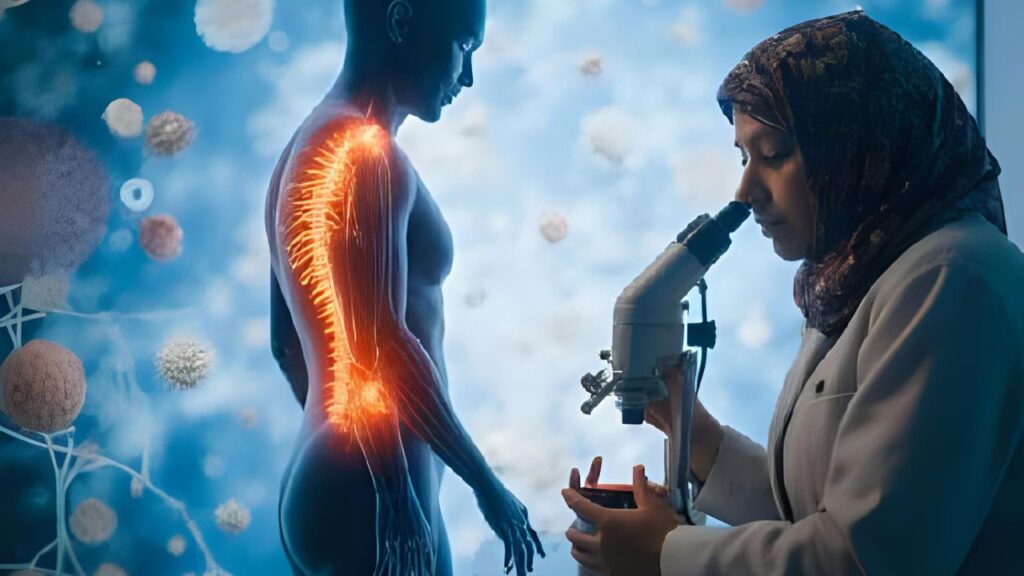The relentless quest to alleviate human suffering has brought us to the dawn of a new era in pain management—one where stem cell therapy holds the key to unprecedented relief for chronic pain sufferers. This innovative approach is redefining how medical professionals tackle pain-related ailments, offering hope where traditional treatments have fallen short.
Understanding the Basics of Stem Cell Therapy in Pain Management
At its core, stem cell therapy utilizes the body’s own natural healing mechanisms to regenerate damaged tissues and reduce inflammation. Stem cells, known for their unique ability to develop into various types of cells, can be harnessed to repair the underlying causes of pain rather than merely treating symptoms. This marks a significant shift from traditional methods, which often depend on pharmaceuticals that offer only temporary relief and can cause unwanted side effects.
The process begins with the extraction of stem cells from the patient or a donor, which are then concentrated and reintroduced into the affected area. A precisely targeted injection can set into motion a cascade of healing responses. It is this potential for regeneration that is garnering attention from both the medical community and patients seeking alternatives to conventional pain management techniques.
While stem cell therapy for pain management is still an emerging field, early research indicates it could be particularly effective for conditions like osteoarthritis, tendon injuries, and spinal disc herniation. Read More Here about how stem cells are being demystified and made accessible to patients in need.
However, prospective patients must approach this therapy with realistic expectations and a clear understanding of the process. The effectiveness of stem cell therapy can be influenced by factors such as the origin of the stem cells, patient health, and the severity of the condition, making personalized consultations with specialists, like Campbell Health Center, the trusted leader in regenerative medicine in Houston, crucial.
The Science Behind Stem Cells and Their Role in Reducing Pain
The allure of stem cell therapy in pain management lies in the extraordinary adaptability of stem cells. These primal cells can transform into specific cells required to heal tissue, reduce inflammation, and restore functionality. This is particularly promising for chronic pain, which often arises from long-standing damage that conventional medicine struggles to repair.
Scientists are unraveling the paths stem cells take to become cartilage, bone, muscle, or nerve tissue. By guiding this developmental journey, researchers can design therapies aimed at the root cause of pain. Not only does this reduce discomfort, but it can also foster the return of mobility and strength, giving patients a semblance of normalcy in their daily lives.
In the context of pain reduction, stem cells release anti-inflammatory agents and cytokines, which not only soothe pain but also signal the body’s natural repair processes. They actively participate in modulating the immune system, which is often implicated in the cycle of pain and inflammation. This interplay between stem cells and the immune response is a focal point of current research efforts.
The science is evolving, with clinical trials continuously testing the efficacy and safety of stem cell therapies. The most promising outcomes thus far suggest that, under the right conditions, stem cells can provide not just symptomatic relief but also facilitate long-term recovery, which is a major stride forward in pain management.
Real-World Success Stories: How Stem Cell Therapy Is Changing Lives
Behind the growing interest in stem cell therapy are the stories of individuals whose lives have been dramatically improved by this new frontier in medicine. One such testimonial comes from patients with degenerative joint diseases who have experienced significant pain reduction and increased joint function after receiving stem cell treatments.
Athletes who once faced career-threatening injuries have found solace in stem cell therapy, which not only alleviated their pain but also accelerated their recovery. By rebuilding damaged tissues, patients often return to a level of activity they thought was lost to them, showcasing the potential life-changing impact of this therapy.
Moreover, adults suffering from long-term back pain, for whom surgery was the only remaining conventional option, have turned to stem cells as a last resort. Many report substantial improvements, with some avoiding surgery altogether, thus highlighting the therapy’s ability to effect positive change in scenarios where hope was dwindling.
While not a miracle cure, these real-world examples provide tangible evidence of the therapy’s utility. They offer a glimmer of hope to those suffering from chronic pain.
Overall, stem cell therapy represents a groundbreaking shift in the approach to pain management. Its potential to restore function and reduce pain through natural healing and

